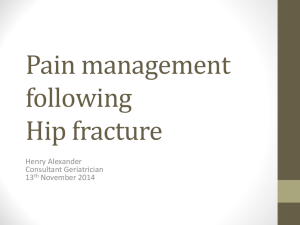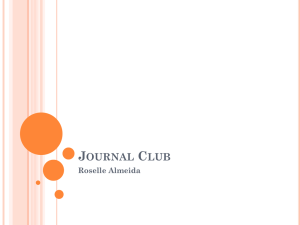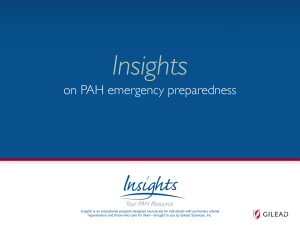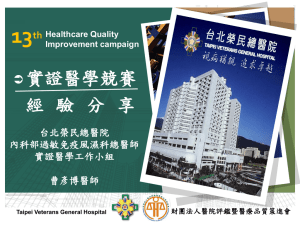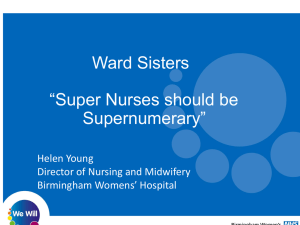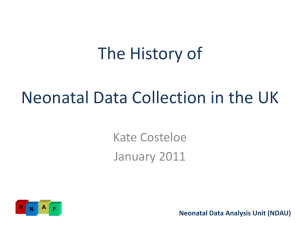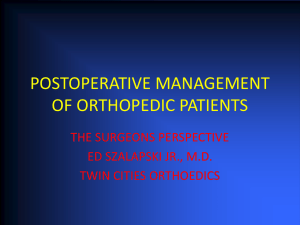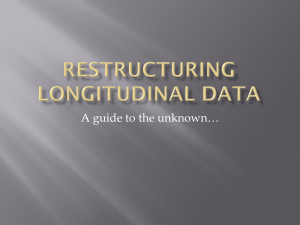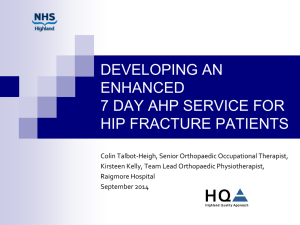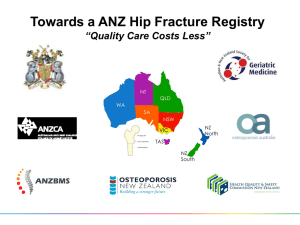Conclusion - The Princess Alexandra Hospital
advertisement
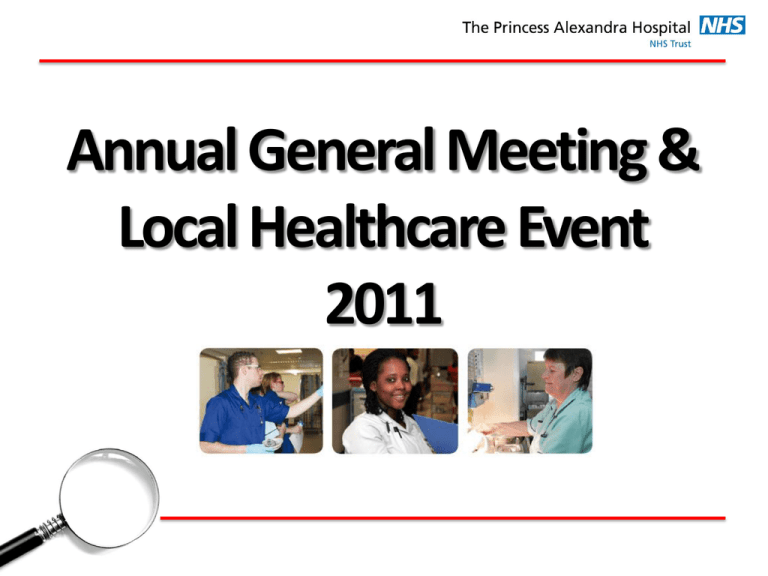
Annual General Meeting & Local Healthcare Event 2011 6:25pm Developments in Maternity and Specialist Baby Care Debbie Twist, Head of Paediatrics 6:40pm Tailored Care for Hip Patients at PAH Dr Jane Snook, Consultant 6:55pm An Operational Overview Darren Leech, Chief Operating Officer 7:00pm The Finances, Charles McNair, Executive Director of Finance 7:05pm The Year Ahead, Melanie Walker, Chief Executive 7:20pm Questions to Speakers 7:30pm Close A Year of Transition Where We Were - Under pressure from key partners due to erratic performance - An uncertain future - Changes at the top Where We Are Now - Good habits versus rocket science - Leadership and behaviours propel successful organisations - Challenging the status quo - Feet firmly on the ground - Focus on the things that matter most £/Q - Our Foundation Trust journey Taking Control Health versus Hospitals - Stronger engagement with stakeholders to meet health needs (versus demand) - Clinical and patient empowerment - Long Term Conditions - Business model will be different Managing the Business - Clearer direction of travel (more later) - Cost control and efficiency - Retaining and attracting the best people - Strong working relations with customers/regulators Remaining Challenges Patient Experience - NHS Achilles heel - Reminders of where we have failed and learning from them - The search is on for Gold Standard at PAH Commissioning for Health - Targets for guidance – not for health! - Managing and self managing Long Term Conditions - Deep and sustainable reform of commissioning – GPs? Chairman’s Pride PAH and Harlow - Nutrition, Cleanliness, Length of Stay, Art in Hospital - Reputation - Partners/Friends Thank You! - Staff - The Board - You Developments in Maternity Services and Specialist Baby Care at Princess Alexandra Hospital Maternity Debbie Twist, Head of Paediatrics The Maternity Unit Births for the last 10 years • 10 years ago (2000/01) 2678 births • 5 years ago (2005/06) 3061 births • Last year (2010/11) 4146 births • Recruitment has been on-going and successful • Midwife to births ratio 1:37 • Our aim is to get this ratio to 1:35 Innovations in Maternity • Caesarean Section Task Force Group • Vaginal Birth After Caesarean - VBAC (80% success rate) • Expansion of the Birthing Unit – 3 pool rooms • Expansion of labour ward – 1 extra delivery room (9 in total) • Extended opening hours of Maternal and Fetal Assessment Unit (MAFU) and Triage • Coming Soon – outpatient induction of labour, telephone triage and gynae ambulatory care PAH Neonatal Unit • • • • • Part of the East Of England Neonatal Network Level 2 Neonatal Unit 16 cots in total - 2 ITU, 4 HDU, 10 SCBU 28 weeks gestation above Equitable, high quality neonatal services – – – – – BAPM Standards DOH Neonatal Toolkit Bliss Report Poppy Report NSF Children and Maternity Services Maintaining Level 2 Unit • • • • • Staffing levels Appropriately trained staff Environment Equipment Services provided THE NEW BUILD IS KEY Our Achievements • Neonatal Consultant, Unit Manager & Clinical Facilitator in post • EOE Neonatal Network protocols • Community Neonatal Nursing team pilot • NEC care bundle • Developmental care • Enhanced Neonatal Nurse Practitioner Community Neonatal Nursing Team • Pilot project June 2010 with West Essex Children’s Commissioners • Early discharge, support parents & families • Repatriation babies • Improved breast feeding rates • Reduction in readmissions Community Neonatal Nursing Team • Total number of cot days saved from June 2010 – June 2011 is 1014 • Comments from service users undertaken have been very positive • Further pilot to extended to 7 days a week from 1st Sept NEC Care Bundle • East of England initiative • Standardise feeding management across network • Training & support • Recent audit PAH top achiever Improved outcomes for neonates Developmental Care Support the holistic development of the pre – term infant • Positioning – head and limbs • Early contact with Mum – kangaroo care Tailored Care for Hip Fracture Patients at PAH Dr Jane Snook Consultant Orthogeriatrician Contents • Epidemiology • Background to changes in hip fracture care • Hip fracture care at PAH – – – – Harold ward Integrated care pathway Results of national audit Future plans • Conclusions Epidemiology of Hip Fractures • • • • • • Commonest serious injury to older people Can bring loss of mobility and independence High costs for society the costs ~ £2 billion/year for the UK Average age 83 3:1 F:M 74% admitted from own home 20% from RH/NH Mobility Independently Mobile 2% 25% 26% 47% Walk with 1 Aid Walk with 2 Aids or Frame Wheelchair Background • Traditional care lead to high mortality and morbidity • About 10% of people with a hip fracture die within 1 month and about one-third within 12 months • High prevalence of comorbidity • BOA and BGS – Blue Book • NHFD launched 2007 • Best practice tariff • NCEPOD November 2010 • NICE guidelines June 2011 Harold Ward • • • • • • Opened in September 2009 28 bedded hip fracture unit Business case developed by hip surgeons Multidisciplinary care led by orthogeriatrician Hip fracture specialist nurse/physio Structured care ICP Hip Fracture Best Practice Tariff • Patients admitted under joint care of geriatrician & orthopaedic surgeon • Seen by orthogeriatrician within 72 hours of admission • Admitted using an assessment protocol agreed by geriatric medicine, orthopaedic surgery and anaesthesia • Surgery within 36 hours from arrival in an emergency department, or time of diagnosis if an inpatient, to the start of anaesthesia • Postoperative geriatrician-directed care • Multi-professional rehabilitation team • Fracture prevention assessments • Falls & bone health Integrated Care Pathway • • • • • • • Assessment by orthopaedics & medics Timely analgesia and investigations Transfer to Harold ward Discussion at trauma meeting Surgery within 36 hours of admission Falls risk and bone health review Early mobilisation and patient-centred discharge Multidisciplinary Care Harold Ward • • • • Daily white board rounds Weekly full MDT meeting Monthly team meetings – NHFD results Mortality review group – Full notes review of all in-hospital deaths • Care of other elderly orthopaedic patients National hip fracture database 2011 Results • 53,443 cases submitted • 176 hospitals • 1st April 10 – 31st March 11 Areas PAH Performing well • All patients admitted under joint care (6% nationally) • All patients receiving medical consultant review preoperatively • Time to theatre <36 hrs (62% nationally 73% PAH) • Surgery during working hours on consultant lead list • All patients admitted to Harold Ward receiving specialist falls assessments by MDT (81% nationally) • All patients admitted to Harold receiving osteoporosis assessment and treatment commenced when appropriate July 2011 PAH Report • • • • • • • • • 24 admissions 7 men 17 women Average age 82 Age range 59-97 70 % directly admitted to Harold (100 % during stay) Average time to ward 11.9 hours 83 % had surgery within 36 hrs 92 % seen by orthogeriatrician within 72 hrs 100 % assessed for bone protection and falls 75 % eligible for best practice tariff Average length of stay 17.3 days (national 20.5) Areas Under Improvement • Pressure sore care (rate 15.5 %) – Full nursing review to optimise nursing numbers and grades – Improvement of processes on ward to ensure optimisation of rehabilitation – Tissue viability support • Time to Harold ward – Close liaison with bed managers – Aim for ring-fenced bed Future Plans • • • • • Ambulance pre-warning A&E Fast transfer to Harold ward Senior physio or nurse to carry bleep Length of stay initiatives Use of Harold ward to benefit other emergency surgical non-hip fracture patients Conclusions • PAH has infrastructure to deliver best practice • Substantial improvements over last 2 years • NHFD and mortality review highlight areas for improvement • Pre-warning by ambulance crews should improve outcomes further Emergency Activity Vs Plan Spells 2,500 2,000 1,500 1,000 500 0 Apr-10 May-10 Jun-10 Jul-10 Aug-10 Sep-10 Oct-10 Nov-10 Dec-10 Jan-11 Feb-11 Mar-11 Actual Plan Planned Care Activity Vs Plan Spells 3,000 2,500 2,000 1,500 1,000 500 0 Apr-10 May-10 Jun-10 Jul-10 Aug-10 Sep-10 Oct-10 Nov-10 Dec-10 Jan-11 Feb-11 Mar-11 Actual Plan National Targets Planned Care Accident and Emergency Scans and Tests Cancer Number of Patients Waiting >18 Weeks Back 4 Hour Emergency Care Target NationalTarget Performance Against Cancer Targets Target % 2010/11 2 Week Wait 93% Compliant 2 Week Breast Symptoms 93% Compliant 31 Day First Treatment Standard 96% Compliant 62 Day Standard 85% Compliant 62 Day Screening 90% Compliant Quality and Safety Improving the Quality of Our Care and Treatment - Introduced protected mealtimes so patients could be helped with eating and drinking where appropriate - Introduced Doctor and Patient/Carer communication surgeries - Less unnecessary time in hospital because of a reduction in our length of stay Providing Better, Safer Services - Remained one of the best hospitals in combating infections - Offering better, safer services – the hospital standardised mortality ratio Conclusion • PAH is a very clean hospital that provides a good standard of care and treatment. • Many successes have been reported despite it being a challenging year. • The Trust saw more patients than planned which impacted our operational performance in some areas. • The challenge is to create a viable healthcare system within which the hospital can consistently perform to a high standard. Our Financial Performance • A small surplus of £415,000 was made • Increasing demands on our own services, particularly emergency • Nearly £6 million invested in the estate, services and equipment • A £5million Cost Improvement Programme was delivered • Achieved all the main statutory financial targets Performance Against Key Statutory Duties Duty 2010/11 Achieved Duty to breakeven remaining within the statutory resource limit (RRL) £415,000 surplus √ Duty not to over-shoot the External Financing Limit £3,306,000 under √ Duty to remain within the statutory capital cash limit (CL) £4,166,000 under √ Our Costs Did You Know? 2/3 of our money is spent on staff Our Capital Expenditure Did You Know? PAH was one of the first to go fully digital for breast cancer screening The Financial Plan for 2011/12 £m Clinical Income Non Clinical Income 164.5 10.2 Sub Total 174.7 Pay 115.0 Non Pay 44.1 Sub Total 164.1 Capital Charges 10.6 Financial Balance 0 The Financial Picture for 2011/12 17 10 Critical Care Elective Outpatients 0.5 2.5 3 A&E/Non Elective Price Deflation Cost Inflation 3 4 4 7 2.5 2.5 4.5 Savings Challenge Capacity Reduction Productivity • • • • • The Way We Work Must Change National Government Reform & Shift in Thinking About How Healthcare is Provided Population Changes – ageing and growing Impact of 21st Century Lifestyles/ Long Term Conditions Rising Drug and Technology Costs Less Money Available for the NHS Building for Excellence We have exciting plans to become one of the best hospitals in the country. The plans, called Building for Excellence, aim to make services more effective and further improve the experience of patients. Financial Performance Patient Experience, Safety and Quality Building for Excellence Operational Excellence Health of the Organisation Our Immediate Plans Clinical Productivity – Build consistency across our operational performance e.g. length of stay, waiting time targets Workforce – Tackle some of the problem areas e.g. sickness, bank and agency usage Staffing – Look at how our back office departments function to protect front line services Other – The way the hospital and wards work Change is Starting to Happen People waiting less time – since April 95% of people have waited less than 4 hours to be seen in A&E, the backlog of people waiting over 18 weeks has halved, and the wait for most tests is less than 6 weeks. Ambulatory Care – patients are seen and a treatment plan started without a need for a hospital stay helping us to use beds and resources better. Conclusion • We are committed to creating a hospital that is one of the best in the country. • Only by securing our financial future will we be able to deliver the quality of care our patients deserve. • It will be tough but we see this as an opportunity to change for the better. Any Questions
